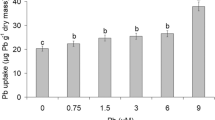Abstract
The aquatic vascular plant Eurasian watermilfoil (Myriophyllum spicatum L.) was investigated for its potential to take up Cd from nutrient-rich water in a short-term growth and harvest regime. Eurasian watermilfoil plants were grown in and harvested weekly from 0.10M Hoagland nutrient solutions containing concentrations of Cd from 0.04 to 7.63μg Cd mL−1. Dry weights of plants significantly decreas4ed when exposed to 7.63μg Cd mL−1. For both 0.04 and 1.03μg Cd mL−1 treatment the greatest concentration of Cd in plants occurred during the first two weeks. The greatest Cd concentration of Cd in plants for the 7.63μg Cd ML−1 treatment occurred during week one and decreased through week 2. Tissue P concentration in control plants increased over time but did not increase significantly over time when plants were exposed to 0.04 and 1.03μg Cd mL−1 levels. Tissue P concentration decreased over time when plants were exposed to 7.63μg Cd mL−1. Stem length, root dry weights, and root number significantly increased over time in control plants and in those exposed to the 0.04 and 1.03μg Cd mL−1 treatments. Plants treated with 7.63μg Cd mL−1 did not grow. These results suggest that Eurasian watermilfoil would be useful for absorbing Cd from nutrient-rich water when the solution concentration was in the range of 0.04 to 7.63μg Cd mL−1. However, in solutions having the highest concentration of Cd, the harvest regime would have to sustain plant vigor, avoid tissue Cd loss, and realize maximum uptake of Cd from solution.
Similar content being viewed by others
References
Adriano, D. C.: 1986, inTrace Metals in the Terrestrial Environment, Springer-Verlag, New York, p. 470.
Association of Official Agricultural Chemists: 1975,Methods ofAnalysis, A. O. A. C., Washington, D.C., p. 1004.
Berry, W. L. and Wallace, A.: 1974,Trace Elements in the Environment — Their Role and Potential Toxicity as Related to Fossil Fuels — A Preliminary Study, Univ. of California at Los Angeles, CA, p. 66.
Chaney, R. L.: 1990,Biocycle 31, 68.
Chen, W., Recht, R. L. and Hajela, G. P.: 1977, ‘Metal Removal and Cynamide Destructin in Plating Wastewaters, Using Particle Bed Electrodes’, in M. F. Smith (ed.),Cadumium Pollution. National Technical Information Science publication, NO. PS-7711020, Springfiled, VA, p. 30.
Chigbo, F. R., Smith, R. W. and Shore, F. L.: 1982.Environ. Pollut. 27, 31.
Cooley, T. N. and Martin, D. F.: 1979,Chemosphere 2, 75.
Davis, W. E. and Associates: 1970,National Inventory of Sources and Emissions of Cadmium, Nickel and Asbestos, U.S. Dept. Health, Edu., and Welfare, Durham, NC, p. 51.
Dymond, G. C.: 1948, ‘The Water-Hyacinth, A Cinderella of the Plant World’, in J. P. J. van Vuren, (ed.),Soil Fertility and Sewage, Dover Publishers, Inc., New York.
Epstein, E.: 1972,Mineral Nutrition of Plants: Principles and Perspectives, John Wiley & Sons Inc., New York, p. 65.
Faoro, R. B. and McMullen, T. B.: 1977.National Trends in Trace Metals in Ambient Air, U.S. Environmental Protection Agency, Research Traingle Park, NC, p. 41.
Fassett, N. C. 1975,A Manual ofAquatic Plants, The Univ. of Wisconsin Press, Madison, WI, p. 405.
Gakstatter, J. H., Allum, M. O., Cominquez, S. E. and Crouse, M. R.: 1978,J. Water Pollut. Contr. Fed. 50, 718.
Hardy, J. K. and O'Keeffee, D. H.: 1985,Chemosphere 14, 417.
Hem, J. D.: 1972,Water Resour. Res. 8, 661.
Hoagland, D. R. and Amon, D. I.: 1950,The Water Culture Method for Growing Plants Without Soil, Calif. (Berkeley) Agric. Exp. Stn. Circ., No. 347.
Jana S. and Chaudhury, M. A.: 1984,Water, Air, and Soil Pollut. 21, 351.
Johnson, C. M. and Ulrich, A.: 1959,Analytical Methods for Use in Plant Tissue Analysis, in Calif. (Berkeley) Agric. Exp. Stn. Bull, No. 766.
Klein, D. H. and Russell, P.: 1973,Environ. Sci. Technol. 7, 357.
Klein, D. H., Andren, A. W. and Bolton, N. E.: 1975,Water, Air, and Soil Pollut. 5, 71.
Kniep, T. J. and Hirshfield, H. I.: 1975,Cadmium in Aquatic Ecosystems: Distribution and Effects, In D. D. Hemphill (ed.),Trace Substances in Environmental Health — VIII, Univ. of Missouri, Columbia, MO, p. 173.
Lewis, R. A., Glass, N. R. and Lefohn, A. S.: 1976,The Bioenvironmental Impact of a Coal Fired Power Plant, Second Interim Report, Clostrip, Montana, U. S. Environmental Protection Agency, Corvallis, OR, p. 315.
Logan, T. J. and Chaney, R. L.: 1983, ‘Utilization of Municipal Wastewater and Sludge on Land-Metals’, inProc. Conf. on Utilization of Municipal Waste Water and Sludge on Land, Univ. of California -Riverside, CA, p. 235.
Low, K. S. and Lee, C. K.: 1981.Pertamika 4, 16.
Martin, A. C., Zim, H. S. and Nelson, A. L.: 1961,American Wildlife and Plants, Dover Publishers, Inc., New York, p. 500.
Mayes, R. A.: 1975, ‘The Role of Aquatic Macrophytes in the Distribution and Cycling of Cadmium and Lead in Aquatic Ecosystems’, Ph.D. Thesis, Purdue University, University Microfilms International, Ann Arbor, MI, p. 204.
Ornes, W. H. and Sutton, D. L.: 1975,J. Aquat. Plant Manage 13, 56.
Ornes, W. H. and Wildman, R. B.: 1979, ‘Effects of Cadmium (II) on Aquatic Vascular Plants’, in D. D. Hemphill (eds.),Trace Substances in Environmental Health, University of Missouri, Columbia, MO, p. 304.
Page, A. L. and Bingham, F. T.: 1973,Residue Rev. 48, 1.
Sloey, W.E., Spangler, F. L. and Fetter, C. W., Jr.: 1978, ‘Management of Freshwater Wetlands for Nutrient Assimilation’, in R. E. Good, D. F. Whigham and R. L. Simpson (eds.),Freshwater Wetlands, Academic Press, New York, p. 321.
Stanley, R. A.: 1974,Arch. Environ. Contam. Toxicol. 2, 331.
Sutton, D. L. and Ornes, W. H.: 1977,Aquat. Bot. 3, 231.
U.S. Environmental Protection Agency: 1978,Health Assessment Document for Cadmium, Office of Research and Development, Washington, DC.
Wolverton, B. C. and McDonald, R. C.: 1978,Water Hyacinth Sorption Rates of Lead, Mercury and Cadmium, N.A.S.A. ERL Report. No. 170.
Author information
Authors and Affiliations
Rights and permissions
About this article
Cite this article
Sajwan, K.S., Ornes, W.H. Cadmium accumulation in eurasian watermilfoil plants. Water Air Soil Pollut 87, 47–56 (1996). https://doi.org/10.1007/BF00696828
Received:
Accepted:
Issue Date:
DOI: https://doi.org/10.1007/BF00696828




